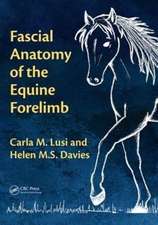Animal Handling and Physical Restraint
Autor C. B. Chastainen Limba Engleză Paperback – 19 feb 2019
Proper handling and restraint are essential to the welfare of captive animals, allowing them to be examined, groomed and treated in ways that contribute to their optimum quantity and quality of life. The aim of the book is to prepare future or current veterinarians and veterinary technologists, technicians/nurses, and assistants to be able to handle animals more safely and gain the confidence of animals and their owners. In turn, they will be able to instruct owners in proper animal handling methods, reducing the risk of physical injury or mutual infectious diseases.
- Covers more species and has greater depth in handling and restraint methods of domestic animals than any of its predecessors and current competitors.
- No other handling book provides this breadth information on the possible zoonoses (animal to human diseases) that might be encountered in handling apparently healthy animals.
- Restraint methods are well described but not in a list or "cookbook" way, as there are always nuances in handling each individual animal that require individual adaptations.
After reading this book, the practitioner or student will be versed in the most basic part of the art of veterinary medicine: the safe handling of animals.
You can hear the author discuss the topics covered in this book on his weekly podcast ‘Better Animal Handling’: https://www.betteranimalhandling.com, discussing content in the book and describing effective, humane animal handling with emphasis on safety measures to prevent injury and the transmission of zoonotic diseases. You can read more on the supporting website: www.betteranimalhandling.com.
| Toate formatele și edițiile | Preț | Express |
|---|---|---|
| Paperback (1) | 326.49 lei 3-5 săpt. | +22.67 lei 6-12 zile |
| CRC Press – 19 feb 2019 | 326.49 lei 3-5 săpt. | +22.67 lei 6-12 zile |
| Hardback (1) | 1004.85 lei 6-8 săpt. | |
| CRC Press – 20 dec 2017 | 1004.85 lei 6-8 săpt. |
Preț: 326.49 lei
Nou
Puncte Express: 490
Preț estimativ în valută:
62.50€ • 64.97$ • 51.82£
62.50€ • 64.97$ • 51.82£
Carte disponibilă
Livrare economică 17-31 ianuarie 25
Livrare express 02-08 ianuarie 25 pentru 32.66 lei
Preluare comenzi: 021 569.72.76
Specificații
ISBN-13: 9780367028329
ISBN-10: 0367028328
Pagini: 408
Ilustrații: 204 Illustrations, black and white
Dimensiuni: 194 x 260 x 39 mm
Greutate: 0.45 kg
Ediția:1
Editura: CRC Press
Colecția CRC Press
ISBN-10: 0367028328
Pagini: 408
Ilustrații: 204 Illustrations, black and white
Dimensiuni: 194 x 260 x 39 mm
Greutate: 0.45 kg
Ediția:1
Editura: CRC Press
Colecția CRC Press
Public țintă
Professional Practice & DevelopmentCuprins
SECTION I: PRINCIPLES OF SAFER HANDLING AND RESTRAINT. Chapter 1: Safer Domestic Animal Handling and Restraint: Attrition of Proper Handling; Types of Handlers and Handling; The More Effective Handler: The Art of Firm Kindness; Conditions for Handling and Restraint; Risks of Injury; Risks of Disease to Handlers and to Other Animals; Ethical Concerns; Sanitation Practicalities; Legal Considerations; Extended Benefits of Animal Handling; Keys to Good Handling of All Animals. Chapter 2: Animal Behavior: Predator or Prey Mentality; Animal Societies; Imprinting Social Behavior with Humans; Flight and Personal Zones; Senses of Danger; Resistance Behaviors; Species Differences in Aggression and Avoidance; Health and Behavior; Stereotypic Behavior; Animal Behavior Specialists. SECTION II: HOUSEHOLD AND LABORATORY ANIMALS. Chapter 3: Containment for Household, Yard, and Laboratory Animals: Confinement and Behavior; Containment and Liability; Dog Containment; Cat Containment; Other Small Mammal Containment; Caged Companion Bird Containment; Reptile Containment.Chapter 4: Dogs: Natural Behavior of Dogs; Safety First; Approaching and Catching; Handling for Routine Care and Management; Handling and Restraint for Medical Procedures by Veterinary Professionals. Chapter 5: Cats: Natural Behavior of Cats; Safety First; Approaching and Catching; Handling for Routine Care and Management; Handling and Restraint for Medical Procedures by Veterinary Professionals. Chapter 6: Other Small Mammals: Natural Behavior of Small Mammals; Safety First; Mice; Rats; Hamsters; Gerbils; Guinea Pigs; Chinchillas; Degus; Sugar Gliders; African Pygmy Hedgehogs; Rabbits; Ferrets. Chapter 7: Companion Birds: Natural Behavior of Companion Birds; Safety First; Approaching and Catching; Handling for Routine Care and Management; Handling and Restraint for Medical Procedures by Veterinary Professionals. Chapter 8: Reptiles: Natural Behavior of Reptiles; Safety First; Turtles and Tortoises; Snakes; Lizards. SECTION III: RANCH, FARM AND STABLED ANIMALS. Chapter 9: Containment for Ranch, Farm, and Stabled Animals: Confinement and Behavior; Containment and Liability; Fences and Gates; Barns, Stalls, and Three-Sided Sheds; Trailering and Other Transportation. Chapter 10: Ropes, Knots, and Hitches: Terminology and Rope Construction; Equipment Maintenance; Equipment Safety; Useful Knots, Bends, and Hitches for Handlers; Using a Lariat. Chapter 11: Horses, Donkeys, and Mules: Natural Behavior of Equids; Safety First; Approaching and Catching; Handling for Routine Care and Management; Handling and Restraint for Medical Procedures by Veterinary Professionals. Chapter 12: Cattle: Natural Behavior of Cattle; Safety First; Approaching and Catching; Handling for Routine Care and Management; Handling and Restraint for Medical Procedures by Veterinary Professionals. Chapter 13: Small Ruminants: Natural Behavior of Small Ruminants; Safety First; Sheep; Goats; Camelids. Chapter 14: Swine: Natural Behavior of Swine; Safety First; Approaching and Catching; Handling for Routine Care and Management; Handling and Restraint for Medical Procedures by Veterinary Professionals. Chapter 15: Poultry: Natural Behavior of Poultry; Safety First; Chickens; Turkeys; Ducks; Geese; Ratites. Appendix: Multi-Species References and Recommended Readings; Transporting and Shipping Animals.
Recenzii
"As a veterinary student, knowing how to handle and restrain a variety of different animals is a necessity. In veterinary school, we are exposed to various species and we need to be confident and competent in how to restrain in order to give the best care possible. Veterinary students will be prompted to handle not only unfamiliar animals, but animals of all temperaments and mind-sets." Animal Handling and Physical Restraint is the amazing animal handling resource that veterinary students never knew they needed."
Kelly Sandelin, University of Missouri College of Veterinary Medicine, Class of 2019
"Animal Handling and Physical Restraint is a comprehensive reference book for anyone working with or around animals, especially those in the veterinary community. It is an excellent resource that describes all aspects of animal handling, regardless of species. The restraint techniques are well described and illustrated. I highly recommend this book and believe it should be on the bookshelf of anyone that works with animals! I’m delighted Dr Chastain wrote this book as I’m certain it will help make countless human/animal interactions safer and less stressful."
Debbie Tate, RVT, VTS (oncology), President, Academy of Internal Medicine Veterinary Technicians (AIMVT)
"I especially like the contrast between doing what is economically necessary versus what is conscience-based, and the reference to inappropriate confinement as abuse. The section on Industial Farm Animal Production is excellent. Overall, this should be mandatory reading for all entrusted to house animals in large scale settings."
Barry Kipperman, DVM, DACVIM, MSc, Adjunct Associate Professor, University of Missouri, College of Veterinary Medicine
"... Succinct, clear, and supplemented well with diagrams... The book does a good job of explaining both how and why certain restraint techniques are preferred, emphasizing animal welfare and human safety."
© Doody’s Review Service, 2017, 3* by Samantha Sander, DVM, Dipl. ACZM (University of Illinois College of Veterinary Medicine)
"The first 3 chapters were a great review of the benefits involved in good animal handling and restraint. I had never really thought of the why behind how veterinary staff handle animals and found these chapters to be a thoroughly interesting read. Some great tables, which summarize the key points involved in animal handling are provided. Each species chapter reviews the behavior of the species and how to be safe when handling that species, going from the basics of handling for routine care to handling for common medical procedures... I thought each chapter was laid out very well and the figures used for restraint demonstrations were well done."
Reviewed by Samantha Fuller, DVM, BSc, Hart Family Veterinary Clinic, Prince George, British Columbia in Can Vet J 2019; 60(10):1098
Kelly Sandelin, University of Missouri College of Veterinary Medicine, Class of 2019
"Animal Handling and Physical Restraint is a comprehensive reference book for anyone working with or around animals, especially those in the veterinary community. It is an excellent resource that describes all aspects of animal handling, regardless of species. The restraint techniques are well described and illustrated. I highly recommend this book and believe it should be on the bookshelf of anyone that works with animals! I’m delighted Dr Chastain wrote this book as I’m certain it will help make countless human/animal interactions safer and less stressful."
Debbie Tate, RVT, VTS (oncology), President, Academy of Internal Medicine Veterinary Technicians (AIMVT)
"I especially like the contrast between doing what is economically necessary versus what is conscience-based, and the reference to inappropriate confinement as abuse. The section on Industial Farm Animal Production is excellent. Overall, this should be mandatory reading for all entrusted to house animals in large scale settings."
Barry Kipperman, DVM, DACVIM, MSc, Adjunct Associate Professor, University of Missouri, College of Veterinary Medicine
"... Succinct, clear, and supplemented well with diagrams... The book does a good job of explaining both how and why certain restraint techniques are preferred, emphasizing animal welfare and human safety."
© Doody’s Review Service, 2017, 3* by Samantha Sander, DVM, Dipl. ACZM (University of Illinois College of Veterinary Medicine)
"The first 3 chapters were a great review of the benefits involved in good animal handling and restraint. I had never really thought of the why behind how veterinary staff handle animals and found these chapters to be a thoroughly interesting read. Some great tables, which summarize the key points involved in animal handling are provided. Each species chapter reviews the behavior of the species and how to be safe when handling that species, going from the basics of handling for routine care to handling for common medical procedures... I thought each chapter was laid out very well and the figures used for restraint demonstrations were well done."
Reviewed by Samantha Fuller, DVM, BSc, Hart Family Veterinary Clinic, Prince George, British Columbia in Can Vet J 2019; 60(10):1098
Descriere
This book prepares veterinarians, veterinary technologists, technicians/nurses, and assistants to be able to handle animals more safely, gain the confidence of animals and their owners, and instruct owners in proper animal handling methods.























